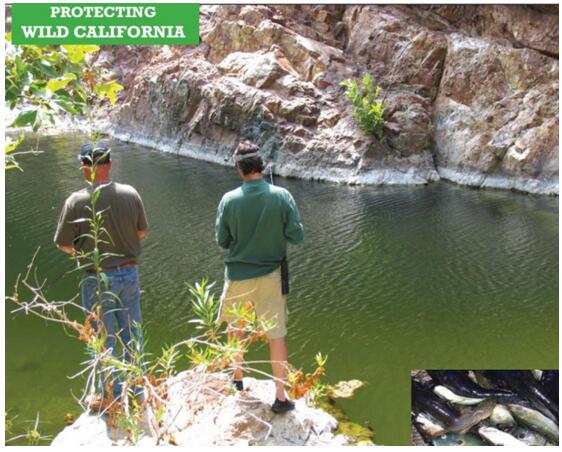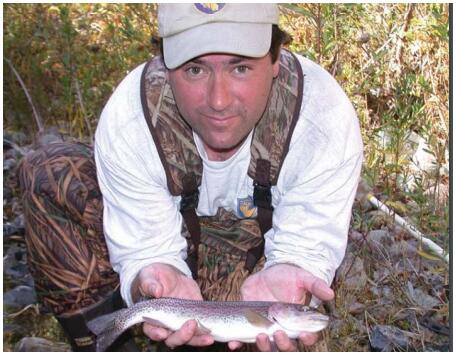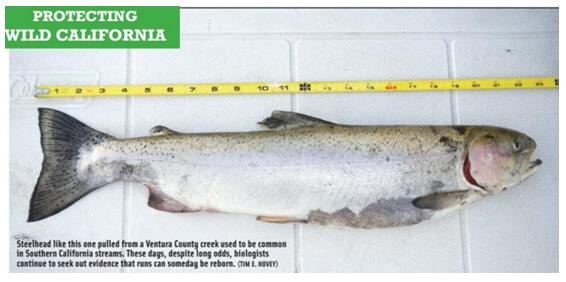Saving Social‘s Steelhead Part II
By Tim E. Hovey
Adapted by Gwen
Despite the grim news, we decided to branch out and search some of the tributaries to San Mateo Creek. With only two side creeks holding water, the effort would be minimal.Adapted by Gwen
The second waterway, Devil canyon Creek, not only held water but also appeared to be free of exotic fish species. The tributary was only yards upstream of the confluence. These fish were slightly larger than the fish downstream, but genetic tests performed later proved that they belonged to the same cohort as the fish downstream. Whether they became stranded in the creek or decided not to migrate downstream to the oceans’ anyone’s guess.
We also confirmed that Devil Canyon was free of invasive fish predators. With the absence of trout in San Mateo Creek above this confluence and the absence of exotic fish in this creek, we were able to determine what occurred in 1997 when the adults entered San Mateo to spawn.
Since these exotic predators would’ve certainly consumed all eggs and fry left by the adults, it makes sense that the steelhead traveled up San Mateo Creek and made it through to Devil Canyon to Spawn. Without the threat of exotic predators, the eggs and fry were left undisturbed, to develop into adult trout.
Evidence of Hope
We monitored the Devil Canyon population for several years, documenting size and behavior, during a spring survey, I noticed that a redd had been constructed in one of the larger pools. A redd is a spawning bed that trout and salmon built to prepare to spawn. Excited by the discovery, we were hopeful that the resident fish would leave offspring.

After monitoring the juvenile trout for a month, a small rainstorm moved through and washed them down into San Mateo, where they were probably preyed upon by the non-native fish. We continued to monitor the adult trout in Devil Canyon until there was only one left. That last fish, a male, was last seen in September of 2003 in a small pool in Devil Canyon Creek.
From their discovery in 1999 to the fall of 2003, resident trout, the offspring of sea-run steelhead, inhabited the wetted sections of San Mateo Creek and Devil Canyon Creek. We determined that anatropous adults had entered the creek in 1997, made their way to Devil Canyon and spawned. Some of those offspring emigrated out of the creek during a high water event in 1999 and were discovered. The remainder stayed in Devil Canyon and spawned the following year, leaving juveniles that likely never made it out of the drainage. The last of the Devil Canyon trout were observed on the drainage in 2003.
A Difficult Place to Spawn
The regular steelhead runs that Southern California used to experience in the 1940s and’50s began to decline sharply when stream access became inconsistent for returning spawning adults. Increased development taxing groundwater, dams and drainage channelization all contributed to a reduced stream flow, limiting or eliminating ocean access.

Occasional access to natal streams may be available during heavy winter storms, when returning steelhead will take advantage of these opportunities to migrate up these creeks to spawn.
Unfortunately, these brief periods of access are inconsistent and extremely limited. If returning steelhead is not staged at the mouth of the creek when it opens up, they may not gain access to complete their life cycle.
Stream access is not the only obstacle steelhead face in returning to the drainages of today. Those fish species that weren’t present in the creeks 60 to 70 years ago now occupy almost all coastal drainages where steelhead historically spawned. Even if returning steelhead can access their home creeks, the presence of these non-native fish would certainly reduce the chance of successful steelhead recruitment.

That same fish will find its way back to that same creek to hopefully access spawning grounds to complete their life cycle. The odds of success after such a lengthy journey are incredibly low. However, even against these insurmountable odds, somehow Mother Nature finds a way.
Editor‘s note: Next month, how the U.S Fish and Wildelife Service Pacific Southwest Region is attempting to restore steelhead runs in Southern California creeks.




